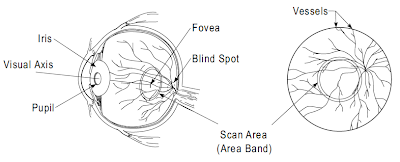There is an old English proverb that states “You get what you pay for,” and this is definitely true of Biometrics. Biometrics includes many technologies from fingerprint scans, to voice recognition, to facial recognition, but none are as reliable and foolproof as the Retina Scan.
Quick disclaimer here, the retina scan is not to be confused with the iris scan, although both scan they eye they are very different and this will be the subject of a future post.
So the retina scanner like the name implies scans your retina. But what is your retina? I’m glad you asked. Retina is just a fancy name for the light-sensitive tissue that lines the inner surface of the eye. This tissue required blood to function properly and thus has an intricate blood vessels system that is called the choroidal vasculature. This vasculature is what is scanned by a retina scanner.
Take a look at the picture below. The part on the left is a cross section of an eye with the retina being what you can see the blood vessels on. The ring that you see in the picture is what is scanned by a retina scanner. This ring can be seen more clearly on the right image which is just a cross section of the eye straight up and down. Everyone has a unique blood vessel pattern and thus it is perfect for biometrics.
Cool, so now we know what a retina scanner scans, but how does it do it? The actual scanning process is very complicated but I will try to give you a basic run down of how it works. Take a look at the following image and don’t freak out, a lot of things are pointed out that are not important to us so just ignore them and pay attention to what I circled in blue that I will talk about.
For simplicity the red arrows you see are how the light would travel from the source through the scanner disk and back to the detector.
So basically, the eye of the person being scanned would be on the left facing inward. That person would look into the camera and would focus on what would look like a pinhole illuminated by a krypton bulb (1). The scanner disk (2) would begin to rotate, creating an infrared (IR, high wavelength non-visible light) scanning beam. The IR beam would be reflected by the choroidal vasculature on the retina to a beam splitter (3) and into a detector (4) that generates the image of the retina.
That is basically how a retina scanner works. The biggest drawback to this technology is that certain diseases can affect your choroidal vasculature, thus causing you to not be authenticated by the scanner. This is also a reason your eye doctor can detect a disease just by looking at your eye.
So that is how the king of Biometrics works. Retina scanning is the most accurate but also the most expensive biometric security tool.
Source: Robert Hill. Retina Identification. Michigan State University. 2005.



I like that you get a bit more into the technological specifics in the post, but without losing your reader. And this is much more interesting given your later posts.
ReplyDelete